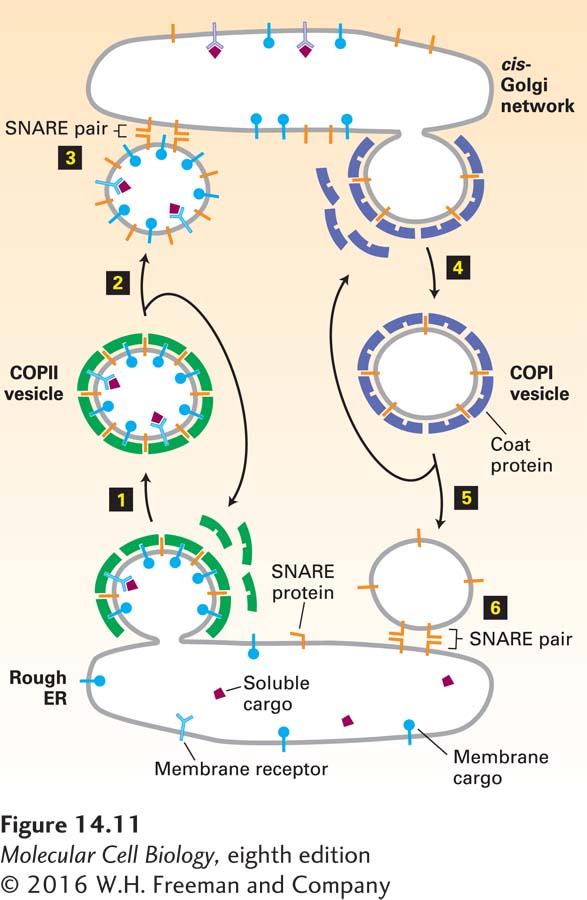14.3 Early Stages of the Secretory Pathway
In this section, we take a closer look at vesicular traffic between the ER and the Golgi and at some of the evidence supporting the general mechanisms discussed in the previous section. Recall that anterograde transport from the ER to the Golgi, the first vesicle trafficking step in the secretory pathway, is mediated by COPII vesicles. These vesicles contain newly synthesized proteins destined for the Golgi, cell surface, or lysosomes as well as vesicle components such as v-SNAREs that are required to target vesicles to the cis-Golgi membrane. Proper sorting of proteins between the ER and Golgi also requires retrograde transport from the cis-Golgi to the ER, which is mediated by COPI vesicles (Figure 14-11). This retrograde vesicle transport serves to retrieve v-SNARE proteins and components of the membrane itself to provide the necessary material for additional rounds of vesicle budding from the ER. COPI-mediated retrograde transport also retrieves missorted ER-resident proteins from the cis-Golgi to correct sorting mistakes.

FIGURE 14-11 Vesicle-mediated protein trafficking between the ER and cis-Golgi. Steps 1–3: Forward (anterograde) transport is mediated by COPII vesicles, which are formed by polymerization of soluble COPII coat protein complexes (green) on the ER membrane. v-SNAREs (orange) and other cargo proteins (blue) in the ER membrane are incorporated into the vesicle by interacting with coat proteins. Soluble cargo proteins (magenta) are recruited by binding to appropriate receptors in the membrane of budding vesicles. Dissociation of the coat recycles free coat complexes and exposes v-SNARE proteins on the vesicle surface. After the uncoated vesicle becomes tethered to the cis-Golgi membrane in a Rab-mediated process, pairing between the exposed v-SNAREs and cognate t-SNAREs in the Golgi membrane allows membrane fusion, releasing the contents of the vesicle into the cis-Golgi compartment (see Figure 14-10). Steps 4–6: Reverse (retrograde) transport, mediated by vesicles coated with COPI proteins (purple), recycles the membrane bilayer and certain proteins, such as v-SNAREs and missorted ER-resident proteins (not shown), from the cis-Golgi to the ER. All SNARE proteins are shown in orange, although v-SNAREs and t-SNAREs are distinct proteins.
We also discuss in this section the process by which proteins that have been correctly delivered to the Golgi advance through successive compartments of the Golgi, from the cis- to the trans-Golgi network. This process of cisternal maturation involves budding and fusion of retrograde rather than anterograde transport vesicles.
